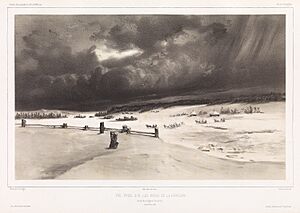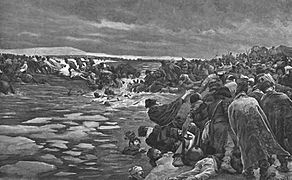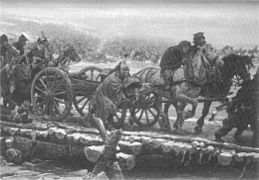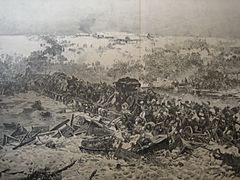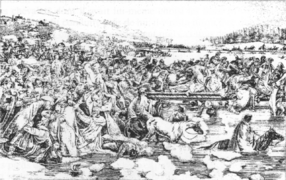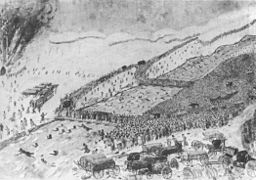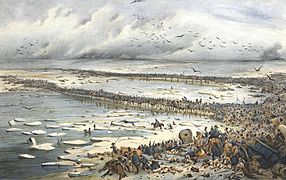Battle of Berezina facts for kids
Quick facts for kids Battle of the Berezina |
|||||||
|---|---|---|---|---|---|---|---|
| Part of the French invasion of Russia | |||||||
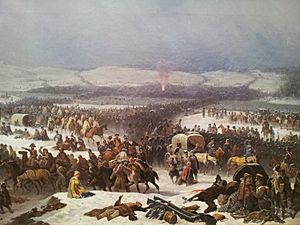 Napoleon's crossing of the Berezina, a 1866 painting by January Suchodolski, oil on canvas, National Museum, Poznań |
|||||||
|
|||||||
| Belligerents | |||||||
| Commanders and leaders | |||||||
| Strength | |||||||
| ~49,000 under arms At least 40,000 stragglers 250–300 guns |
|
||||||
| Casualties and losses | |||||||
| 20,000 to 30,000 combatants 30,000 noncombatants |
10,000 killed Many more wounded |
||||||
The Battle of Berezina happened from November 26 to 29, 1812. It was fought between Napoleon's army, called the Grande Armée (which means "Great Army"), and the Imperial Russian Army. The main Russian commanders were Field Marshal Wittgenstein and Admiral Chichagov.
Napoleon's army was trying to retreat from Moscow and cross the Berezina River near Borisov. The battle didn't have a clear winner. Even though Napoleon's army lost many soldiers, he managed to cross the river. This allowed the remaining parts of his army to continue their difficult retreat.
Contents
Why the Battle Happened
Napoleon's army was leaving Russia after fighting battles like Maloyaroslavets and Krasnoi. His plan was to cross the Berezina River at Borisov. He hoped to meet up with his ally, Field Marshall Schwarzenberg, at Minsk.
As Napoleon's main army marched towards Borisov, Russian troops and Cossacks tried to block them. Napoleon's army was in bad shape. He had about 49,000 soldiers ready to fight and another 40,000 people who were following along, but not armed.
On November 21, the Russians attacked and took over the French base at Borisov. This included the important bridge over the Berezina River. A French group tried to get Borisov back on November 23, but the Russians destroyed the bridge. They kept control of the river's west side.
To the north, Russian Field Marshal Wittgenstein and his army of 30,000 followed Napoleon. From the west, Russian Admiral Chichagov and his army of 35,000 moved towards Borisov. Also, Russian General Miloradovich with 32,000 soldiers was chasing Napoleon from the east.
On November 23, 1812, a special cavalry unit was formed called the Sacred Squadron. It was made up only of officers. They served as Napoleon's personal bodyguards because the army was running out of regular cavalry.
Crossing the River and Fighting
When Napoleon's army reached Bobr, they learned the bridge at Borisov was destroyed. But a French cavalry group found another possible crossing point. It was eight miles north of Borisov, at a small village called Studienka. Usually, the river would be frozen there in November. However, a warm spell had melted the ice. This meant bridges had to be built.
Plans were made to build floating bridges. General Jean Baptiste Eblé, who led the bridge builders, had kept the tools needed for this. He had ignored Napoleon's earlier orders to destroy all equipment during the retreat. To trick the Russians, the French made many fake moves. On November 25, they started building bridges at Studienka. They saw many Russian campfires across the river, but they hoped the Russians wouldn't notice.
French General Nicolas Oudinot's army movements and rumors made the Russians think Napoleon would attack Borisov. They thought he might try to fix the bridge there. Or, they believed he would cross the Berezina River further south. Because of this, Admiral Chichagov moved most of his army south of Borisov. He wanted to watch a long stretch of the river. Russian General Tshaplitz and his 3,000 men, who were camped at Brili, were ordered to move south.
So, on the morning of November 26, the French found that the Russians had left the west bank. Forty French cavalry soldiers crossed the river first. Then, 400 men crossed in boats. This small group secured the west bank so the bridges could be finished. Meanwhile, the Russian armies chasing Napoleon from behind were not very aggressive. They stayed far away from the Berezina River while the French built the bridges. The river was 20-30 meters wide and full of floating ice. Its banks were swampy, making the crossing very hard.
By 1 p.m., the smaller of the two bridges was ready. General Oudinot began leading his 7,000 infantry soldiers across. They set up a defensive position to protect against Russian forces to the south. Later that afternoon, the larger bridge, meant for artillery, was finished. But it broke twice. Napoleon then began moving his army across the Berezina in large numbers.
Overnight, on November 26-27, Russian General Chaplitz realized the French were crossing. He gathered his forces and tried to return to Brili to stop the French. However, Oudinot's soldiers stopped Tshaplitz's forces well south of Brili. Also on the 27th, Chichagov started moving his main army back to Borisov. He saw there was no French activity downstream. But Chichagov chose not to move north to Brili right away. His men were still moving and not fully ready.
By midday on the 27th, Napoleon and his Imperial Guard had crossed. One of the bridge sections broke late in the afternoon. But the engineers fixed it by early evening. The armies of Marshal Davout and Prince Eugene were able to cross before the day ended. The last French group on the eastern bank was Marshal Victor's IX Corps. They were ordered to defend against Wittgenstein, who had reached Borisov. During this defense, French General Louis Partouneaux's division lost badly. They surrendered over 8,000 men when Wittgenstein overwhelmed them.
On November 28, the Russians attacked Napoleon's army on both sides of the river. On the west bank, Tshaplitz, with more soldiers, attacked the French. He started pushing Oudinot back towards Brili. French General Ney took command when Oudinot was hurt. The Russian advance was stopped. Twenty-five thousand men fought in a battle that lasted into the night. Finally, French General Doumerc led a cavalry charge. This forced the Russians back and ended the fighting for the day.
On the east bank, Wittgenstein attacked Victor's IX Corps at 5 a.m. The French were pushed back in a fight that lasted eight hours. At 1 p.m., the Russians got into a position where they could attack the French from the side. They began firing cannons at the bridges. The cannon fire mostly hit the unarmed people trying to cross. This caused a huge rush as people ran for the bridges. Some jumped into the cold river to try and swim across. The fighting and bombing lasted about four hours. Then, the bridge engineers started clearing a path for Victor's IX Corps to cross.
Around 10 p.m. that night, Victor's IX Corps crossed the river. Three hours later, the bridges were clear of Napoleon's armed troops. The bridges were then open for the unarmed people. However, many who had fought hard to cross earlier chose to stay on the east bank. They lit campfires and spent the night there. The next morning, General Eblé, the engineer commander, had Napoleon's order to burn the bridges at 7 a.m. Eblé waited until 8:30 a.m. before burning them. This left tens of thousands of unarmed people and civilians behind.
The people left behind faced a terrible fate. Many tried to swim across the icy river but did not make it. Carts and horses also fell from the bridge. Once the bridges were burned, the scene was very sad and difficult to describe.
Cossacks and Wittgenstein's troops then captured the people left on the east bank. With the bridges gone, Wittgenstein could not cross the river to chase Napoleon. On the west bank, Napoleon and his army were heading towards Vilna. Chichagov sent Chaplits to chase Napoleon. But the French had destroyed three bridges across a swamp. The swamp could not be crossed without the bridges. Napoleon had escaped. The battle at the Berezina River was over.
What Happened After
The Battle of Berezina meant that the French retreat continued, with the Russian Army still following. Even though the Russians caused more losses, they didn't fully stop Napoleon. Napoleon managed to save what was left of his army from a disaster. There were no more big battles during the rest of the retreat. However, the constant attacks from Russian Cossacks and the harsh weather continued to harm the French army.
The losses were huge. It's thought that 20,000 to 30,000 French soldiers were killed or wounded during the three days of fighting. Another 30,000 unarmed people also died or were captured. The French lost very few cannons, only 25. The Russians lost at least 10,000 soldiers and many more were wounded.
Even though many were lost, Napoleon, his generals, 200 cannons, and thousands of experienced soldiers escaped. About 40,000 members of Napoleon's army were saved. These experienced men were very important. Without them, Napoleon could not have rebuilt his armies for future battles.
The days after the battle were very hard. People were so hungry that they ate anything they could find. This included dead horses, dogs, cats, and even the bodies of those who died from cold and hunger.
Napoleon left his army on December 5 at Vilna. The temperatures dropped to -33.75 °C on December 8. The number of fighting soldiers was down to only 4,300. On December 14, the rest of the main French army crossed the Niemen River. Between December 1 and 14, 36,000 French prisoners were taken by the Cossacks.
Out of 612,000 soldiers who entered Russia, only about 110,000 were left. This included the armies on the sides and some unarmed people. The Russians also lost many soldiers, possibly around 250,000.
Gallery
The dramatic story of the battle has inspired many artworks:
See also




